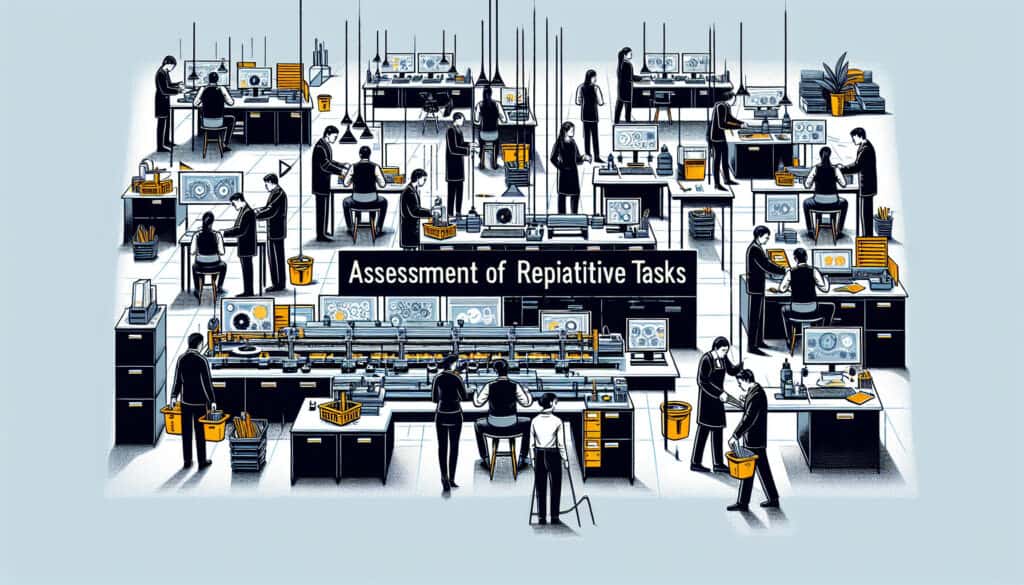Un outil développé par le Health and Safety Executive (HSE) du Royaume-Uni pour aider à évaluer les risques liés aux tâches répétitives.
- Méthodologies : Clients et marketing, Idéation, Conception de Produits
Évaluation des tâches répétitives (ART)

Évaluation des tâches répétitives (ART)
- Amélioration continue, Ergonomie, Facteurs humains, Ingénierie des facteurs humains (HFE), Amélioration des processus, Gestion de la qualité, Analyse des risques, Gestion des risques, Safety
Objectif :
Comment il est utilisé :
- L'outil ART est une simple liste de contrôle qui aide les utilisateurs à évaluer les facteurs de risque associés aux tâches répétitives, tels que la répétition, la force et la posture. Il fournit un score numérique qui peut être utilisé pour hiérarchiser les tâches à haut risque.
Avantages
- Il s'agit d'un outil simple et facile à utiliser, qui peut être utilisé par des personnes ayant une expertise limitée en matière d'ergonomie et qui fournit un moyen clair et simple d'évaluer les risques liés aux tâches répétitives.
Inconvénients
- Il s'agit d'un outil de dépistage qui peut ne pas être suffisant pour une évaluation ergonomique détaillée, le système de notation est subjectif et il peut ne pas être applicable à tous les types de tâches répétitives.
Catégories :
- Ergonomie, Ressources humaines, Gestion des risques
Idéal pour :
- Évaluation des risques de troubles du membre supérieur dans les tâches répétitives.
La méthodologie d'évaluation des tâches répétitives (ART) est largement applicable dans des secteurs tels que la fabrication, la logistique, les soins de santé et les chaînes de montage, où les mouvements répétitifs sont fréquents. Cet outil est particulièrement utile pendant la phase de conception de nouveaux produits ou systèmes, où la compréhension de l'impact ergonomique sur les travailleurs peut guider les modifications avant la mise en œuvre à grande échelle. L'ART aide à identifier les tâches qui comportent un risque plus élevé de troubles des membres supérieurs, ce qui permet aux équipes de donner la priorité aux interventions qui réduisent ces risques. Les participants à cette évaluation sont généralement des ergonomes, des experts en santé au travail et des responsables de production qui peuvent utiliser efficacement la liste de contrôle ART même s'ils ont des connaissances de base en ergonomie. La notation numérique fournie par ART permet non seulement de classer les tâches en fonction des risques, mais aussi de faciliter la communication sur les problèmes de sécurité entre les parties prenantes du projet. Des études de cas portant sur des chaînes de montage automobile ont démontré une réduction significative des accidents du travail à la suite d'évaluations ART, illustrant ainsi son application pratique dans des scénarios concrets. La simplicité d'ART en fait un outil accessible aux organisations qui cherchent à améliorer l'ergonomie sur le lieu de travail sans avoir besoin d'une formation avancée, ce qui en fait une ressource précieuse pour les opérations de petite ou grande envergure visant à améliorer la sécurité et la productivité des travailleurs.
Principales étapes de cette méthodologie
- Identifier et énumérer les tâches répétitives effectuées.
- Évaluer la fréquence d'apparition de chaque tâche au cours d'une période donnée.
- Évaluer le niveau de force appliqué pendant les tâches à l'aide de mesures standard.
- Analyser la posture adoptée pendant l'exécution de la tâche, en notant toute position inconfortable.
- Attribuer une note numérique basée sur les critères d'évaluation de la répétition, de la force et de la posture.
- Calculer le score total pour chaque tâche afin de déterminer les niveaux de risque.
- Hiérarchiser les tâches en fonction de leur score de risque total pour une action ou une intervention ultérieure.
Conseils de pro
- Intégrez des boucles de retour d'information dans vos évaluations ART en recueillant les commentaires des personnes directement impliquées dans les tâches répétitives ; cela peut révéler des facteurs de risque négligés et améliorer la précision.
- Utiliser le système de notation ART pour guider les processus d'amélioration continue, en veillant à ce que les tâches à haut risque fassent l'objet d'une intervention prioritaire et d'un suivi dans le temps afin d'évaluer l'efficacité des changements mis en œuvre.
- Combiner l'évaluation ART avec des méthodes d'observation et des outils ergonomiques supplémentaires, afin de créer une approche globale qui prenne en compte les facteurs de risque qualitatifs et quantitatifs pour améliorer les stratégies d'intervention.
Lire et comparer plusieurs méthodologies, nous recommandons le
> Référentiel méthodologique étendu <
ainsi que plus de 400 autres méthodologies.
Vos commentaires sur cette méthodologie ou des informations supplémentaires sont les bienvenus sur le site web de la Commission européenne. section des commentaires ci-dessous ↓ , ainsi que toute idée ou lien en rapport avec l'ingénierie.
Contexte historique
1986
(si la date est inconnue ou n'est pas pertinente, par exemple "mécanique des fluides", une estimation arrondie de son émergence notable est fournie)

Articles Similaires
Gestion des opérations de fabrication (MOM)
Système d'exécution de la fabrication (MES)
Plan de contrôle de la fabrication
Tests manuels
Tableaux d'évaluation des manutentions manuelles (MAC)
ManTRA (outil d'évaluation des risques liés aux tâches manuelles)